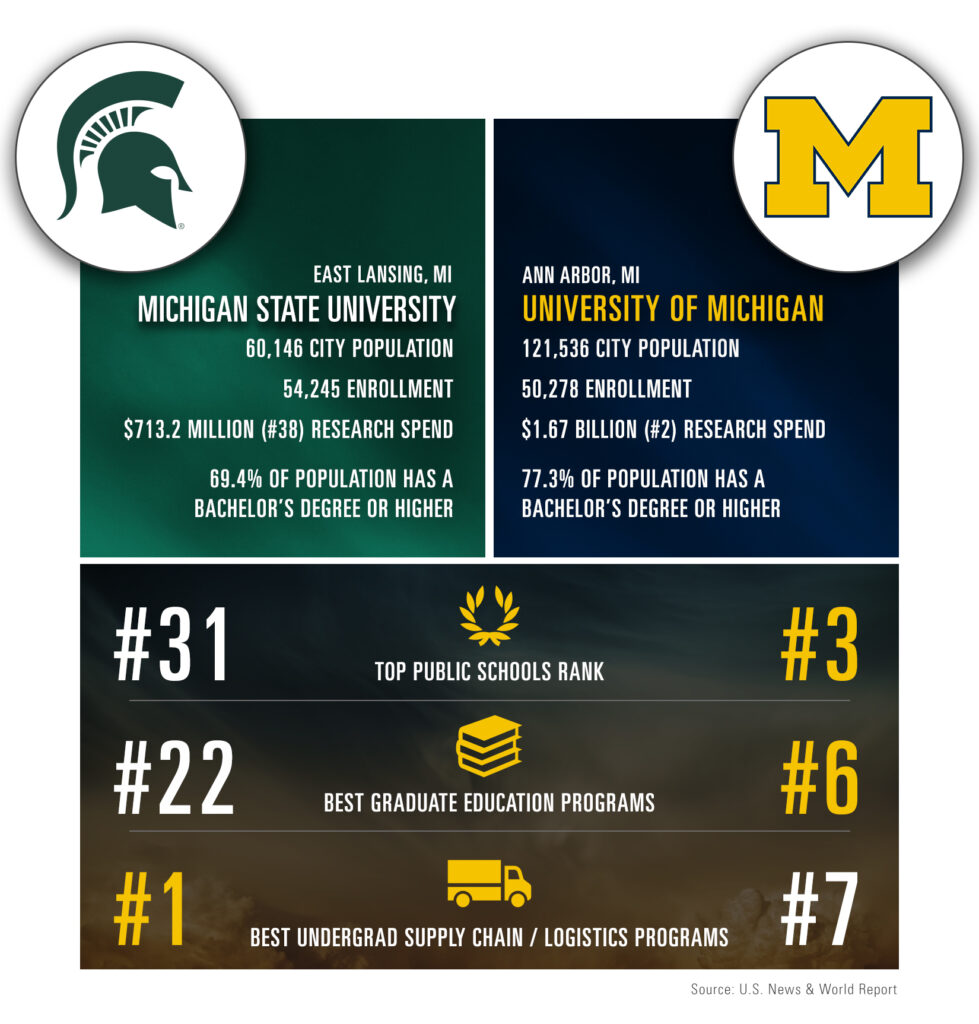
Week 9: Saturday, October 29, 2022 | Michigan vs. Michigan State | Michigan Stadium | 7:30 p.m. EST
Ann Arbor SPARK’s popular football blog series is back for Michigan’s 143rd season! We use the football season as an opportunity to compare Ann Arbor to cities around the country represented by our U-M football competition. The question is always – how does Ann Arbor compare to other college towns in the U.S.?
For Michiganders, this weekend will be a little tenser than others. We are headed into the first big rivalry game of the season — one that divides many college football-loving households into either Maize and Blue or Green and White corners. With both teams coming off of a bye week, it will be interesting to see which team has what it takes to bring home the coveted Paul Bunyan Trophy along with the bragging rights that come with it.
The undefeated Wolverines will be home in the Big House to take on the Michigan State Spartans in a highly anticipated night game. Michigan and Michigan State last met in October last year and the matchup resulted in a big win for Michigan State (33-37). The two teams have met 96 times since 1918 and Michigan has won 56 of the 96 games (58 percent). Michigan has not defeated Michigan State since 2019 and looks to break that streak this weekend.
Unlike our usual comparisons, these two cities are in the same state, which both simplifies and complicates the equation. Some variables are held constant, while others are placed in the spotlight. Considering the delicate balance, there is more context to discuss this week than usual:

- Michigan State is located in East Lansing, a separate city (statistically and municipally) from Lansing, though they are clearly interconnected.
- Lansing is the State Capital, where the major local industry is the state government — an oddity compared to other metropolitan areas.
- East Lansing is a town of approximately 60,000, while Lansing is closer to 160,000. Their combined total is larger than Ann Arbor, though their distance from a major metropolitan area like Detroit is greater.
Not surprisingly, the two regions that include Ann Arbor and Lansing/East Lansing are the two most educated regions in the state of Michigan. Graduates from both Michigan and Michigan State contribute to the State of Michigan claiming the highest concentration of engineering talent in the nation.
The football rivalry between Michigan State and the University of Michigan may be historic and traditional, but as Michiganders, we all benefit from their continued academic and athletic prowess. Both schools belong to the University Research Corridor, including Wayne State University, which is very attractive to a variety of industries and companies looking to locate their facilities in Michigan – yay for economic development!
In terms of the state’s labor force, both universities clearly contribute to our foundation of high-quality talent. According to surveys conducted by the career services centers at each school, 64 percent of MSU grads and 35 percent of U-M grads remain in Michigan after graduation. It is important to note that this stat comes with caveats: the University of Michigan attracts more out-of-state and international students, which could drive the percentage down. Further,, this statistic does not necessarily consider alumni who return to Michigan some years later.
Overall, it’s useful to contemplate the educational and post-educational pathways of the workforce in Michigan, especially now when many occupations can be performed remotely and our companies are competing for talent globally.
- Week 1: Ann Arbor vs. Fort Collins
- Week 2: Ann Arbor vs. Honolulu
- Week 3: Ann Arbor vs. Storrs Mansfield
- Week 4: Ann Arbor vs. College Park
- Week 5: Ann Arbor vs. Iowa City
- Week 6: Ann Arbor vs. Bloomington
- Week 7: Ann Arbor vs. State College
- Week 8: Bye Week
Sources
Where do we get our numbers? And what do they mean?
- Population data comes from the U.S. Census, 2021 Population Estimates. Check out Ann Arbor’s data.
- Enrollment data comes from the Integrated Postsecondary Education Data System (IPEDS). Review University of Michigan data.
- Research expenditure data comes from the National Science Foundation. View the Rankings by Total R&D Expenditures.
- Educational attainment data comes from the US Census 2016-2020 American Community Survey Five-Year Estimates. We look specifically at the population over the age of 25, and the highest level attained. Check out Ann Arbor’s data.
- The rankings come from U.S. News and World Report unless otherwise noted.